4 Ways to Avoid Chafing at the Gym
Posted by Jack Miller on 15th Jul 2020
Hitting the gym after a long day's work can be physically challenging enough without having to worry about chafing. Unlike hiking, running, or many other activities, a tough gym session gets your body and legs moving in a range of different ways; and this can provide an array of problems for those suffering from chafed thighs. With these four simple steps, you can avoid dealing with unwanted and uncomfortable rashes, and can give it your all in the gym.
Don't sweat it!
It's no secret that sweat is the primary cause of chafing during workouts. Of course, preventing this is easier said than done – particularly for those looking to perform at their best. Make sure to wash and dry properly after a workout; and if you see a rash developing, make sure to apply antibacterial ointment or rub vitamin E cream on the affected areas.
It's also important to remember the link between temperature and chafing. Though it may not always be possible, try to work out at a gym with efficient air conditioning, and make sure to cool down and stay hydrated appropriately.
Wear the right gear.
Another common suspect for chafing is loose-fitting clothing – so make sure your gear fits properly. It's best to avoid cotton, as it can become damaging once wet, which is the reason why activewear brands tend to stick to synthetics. For men and women suffering from inner thigh chafing, No More Chafe Thigh Guards are a no-brainer, because they move with your body. If you crouch, the thigh guards will adjust and adapt as your body crouches, the same happens when you jump, sprint, bend, walk, twist or do any movement you want. Many short-course runners and marathon runners may opt to wear a pair of anti chafing shorts, this may be suitable for people who are strictly running, without many other movements involved. Make sure to wear the gear that fits you appropriately and is suitable to your activity.
Create a barrier.
For many suffering from chafing, this is their first go-to: because this is what we are taught as children. Spreading a light layer of a lubricant product, such as Vaseline or talcum powder can help absorb the sweat that contributes to rashes but it is no chafing cure. In fact, many of these products don't really work all that well. Whilst you can short-term relief, the cream or balm that you're using will soon wear off, because your thighs are constantly rubbing together. Because, your skin is never actually physically protected with these products, it may not be a worthy investment. Particularly for those engaging in high-intensity cardiovascular exercise or even HIIT.
Mix it up.
If a workout (or even a particular exercise) leaves your skin irritated, opt for a different type of routine next time you hit the gym. It's well-known in the workout world that alternating between different muscle groups allows affected areas time to recover, and this advice spills over into chafing prevention. And while this is particularly important advice for the runners and the cardio bunnies amongst us, it's certainly also applicable to those with a preference for other areas. Deadlifting and squatting are well-known for their chafing effects – but for many heavy lifters, upper body and torso rashes can also be of concern.
A growing body of evidence also supports the idea that carrying out more strenuous exercises in the early morning or evening (when it's cooler out) can be immensely beneficial for those suffering from chafing. Of course, chafing effects everyone differently, so it's best to experiment with your routine to figure out what works best for you.

